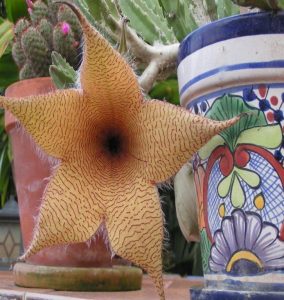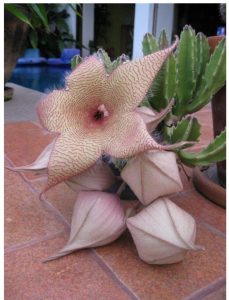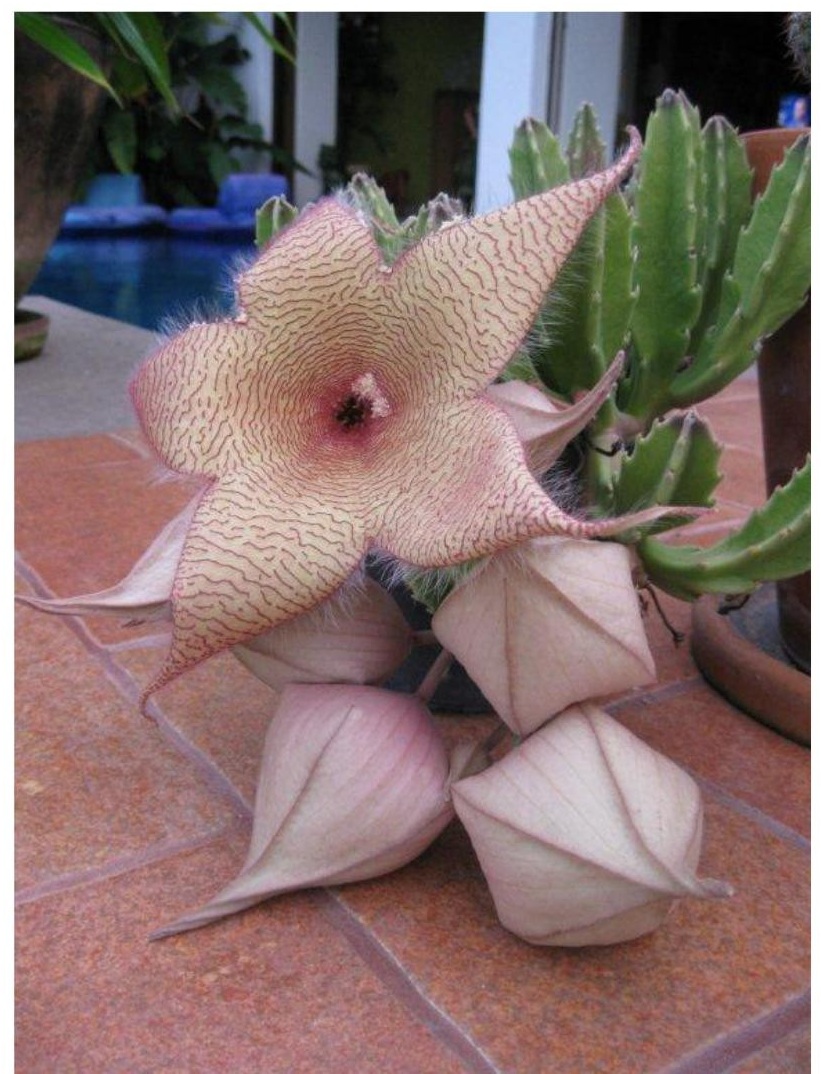By Tommy Clarkson from the December 2012 Edition
Stapelia gigantean
Family: Asclepiadaceae
(Also known as a Carrion Flower, Carrion Plant, Carrion Lily, Toad Cactus, Zulu Giant or Hairy Giant Starfish Flower)

In the Asclepiadaceae Milkweed or Madagascer Jasmine family, there are around 100 species of the succulent perennial Stapelia. They originated in the semi-arid tropical and subtropical regions of Africa and India. This particular one the Stapelia gigantean – comes from northwestern South Africa. A rather curious and intriguing succulent, it has a major flowering (and smelling) attitude!

Resembling a cactus, but without thorn, its blooms explode forth from leafless, knobby, fleshy, ascending, four-ridged stems. These scalloped ridges sport upward pointing soft “teeth.” While in the species whole the stem colors vary from bright green through olive green to a brownish green, the color of the Giant Starfish – most often around 25.5 cm (10”) in length is pale green.
One morning recently I noted that, in one stage or another, our little plant had seven blooms. In others of this species, these beautiful, attention getting, perfect star shaped flowers can be as big as 45.7 cm (18”) across. But sweet of aroma they definitely are not!
Actually, they have a rather putrid, nauseating, smell hence the alternate name of Carrion Flower. (Some folks have observed that its odor is similar to that of rotting flesh!) These stunningly attractive blooms are, many times, flesh-colored, often rimmed in crimson and are covered with soft, white, silky hairs. To the compound eyes of carrion insects these hairs resemble a layer of mold growing on rotting matter which, in bug speak, says “Yum yum!” This “scent of death” attracts carrion beetles and blowflies, flesh flies and midges to the central orifice where the male and female floral sex organs are located.
The extremely attractive and exotic looking, five petaled flower is also found in the colors of red, yellow, brown and purple. With beauty within beauty, often there is a small star within the star shaped bloom. In maturity these plants should grow to about a foot tall. So large and heavy are these flowers that they generally come to rest on the ground.
 As plastic tends to keep moisture in longer these are best grown in clay pots. Good drainage is important hence be careful to not overwater. They are prone to root rot, so use a good, sterile potting soil leaning toward sandy. Grown indoors or out, it likes humid or dry air.
As plastic tends to keep moisture in longer these are best grown in clay pots. Good drainage is important hence be careful to not overwater. They are prone to root rot, so use a good, sterile potting soil leaning toward sandy. Grown indoors or out, it likes humid or dry air.
What with blooms that are larger and more pendulous than its stems they are excellent plants when used in a semi-cascading venue.
Purportedly most happy in morning sun to afternoon shade mine is in full sun all of the time. They are easy to propagate. So when you wish more, simply cut or snap off a stem, let it air-dry in shade for a day or so and then plant it right side up.
Planted with smaller succulents they are – in the words of the botanical great, Robert Lee Riffle, “wonderfully outlandish.” I though no where the intellect as he wholly agree!

Download the full edition or view it online
—
Tommy Clarkson is a bit of a renaissance man. He’s lived and worked in locales as disparate as the 1.2 square mile island of Kwajalein to war-torn Iraq, from aboard he and Patty’s boat berthed out of Sea Bright, NJ to Thailand, Germany, Hawaii and Viet Nam; He’s taught classes and courses on creative writing and mass communications from the elementary grades to graduate level; He’s spoken to a wide array of meetings, conferences and assemblages on topics as varied as Buddhism, strategic marketing and tropical plants; In the latter category he and Patty’s recently book, “The Civilized Jungle” – written for the lay gardener – has been heralded as “the best tropical plant book in the last ten years”; And, according to Trip Advisor, their spectacular tropical creation – Ola Brisa Gardens – is the “Number One Tour destination in Manzanillo”.





You must be logged in to post a comment.